The Power of Persuasion: Anne Elliot's Journey in Austen's Novel
VerifiedAdded on 2022/08/28
|8
|2189
|17
Essay
AI Summary
This essay delves into Jane Austen's novel 'Persuasion,' focusing on the character of Anne Elliot and exploring the themes of women's perspective, societal expectations, and the power of persuasion. The analysis examines Anne's character development through three distinct stages, highlighting her strength, resilience, and journey to self-acceptance and love. The essay connects Anne's experiences to Austen's personal life and the broader context of societal norms. It also discusses the portrayal of women in Austen's works, emphasizing their voices and challenges to patriarchal expectations. The essay uses various critical perspectives and adaptations of the novel to provide a comprehensive understanding of the themes and characters, emphasizing the enduring relevance of the novel's exploration of love, self-discovery, and the challenges faced by women in society.
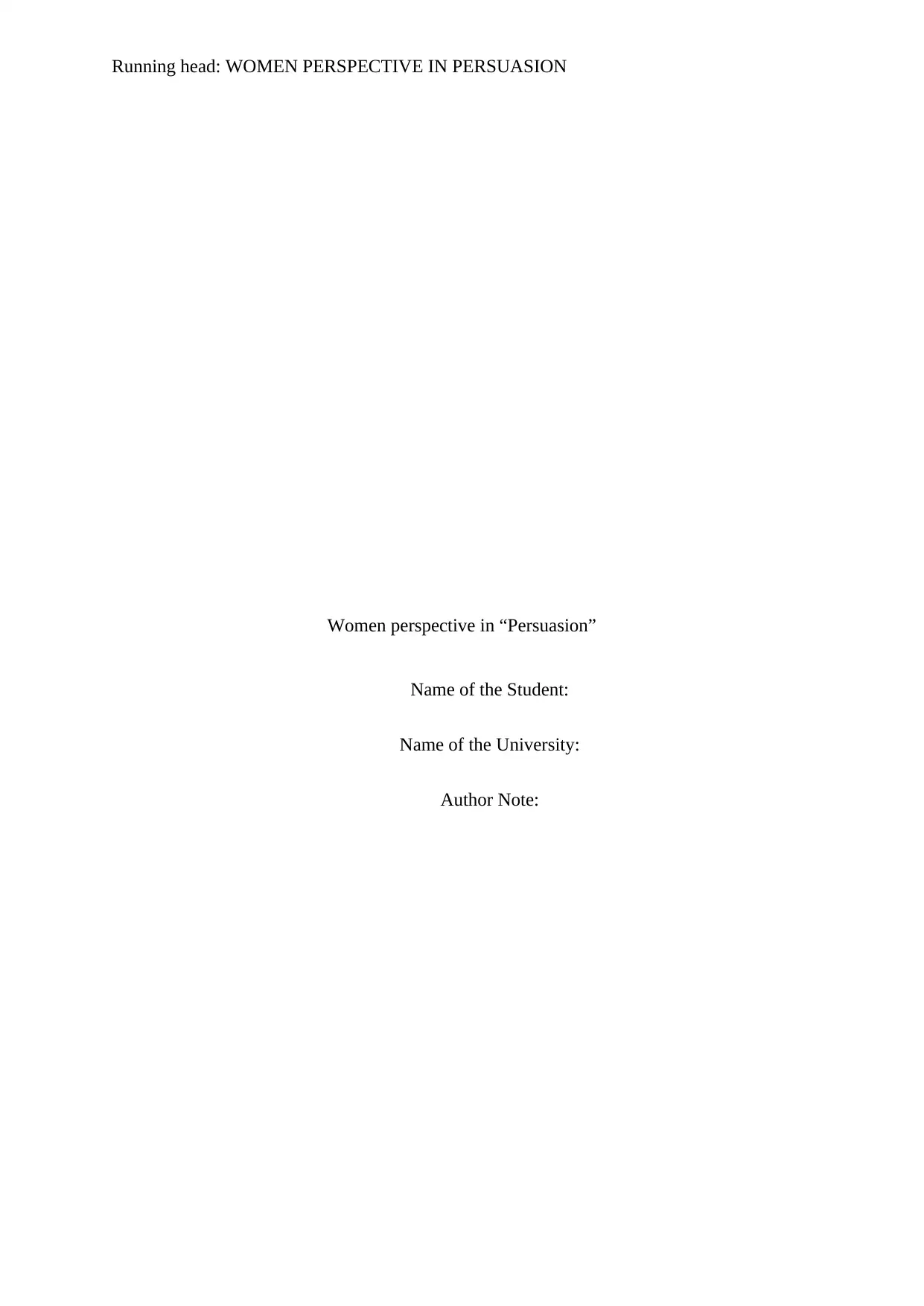
Running head: WOMEN PERSPECTIVE IN PERSUASION
Women perspective in “Persuasion”
Name of the Student:
Name of the University:
Author Note:
Women perspective in “Persuasion”
Name of the Student:
Name of the University:
Author Note:
Paraphrase This Document
Need a fresh take? Get an instant paraphrase of this document with our AI Paraphraser
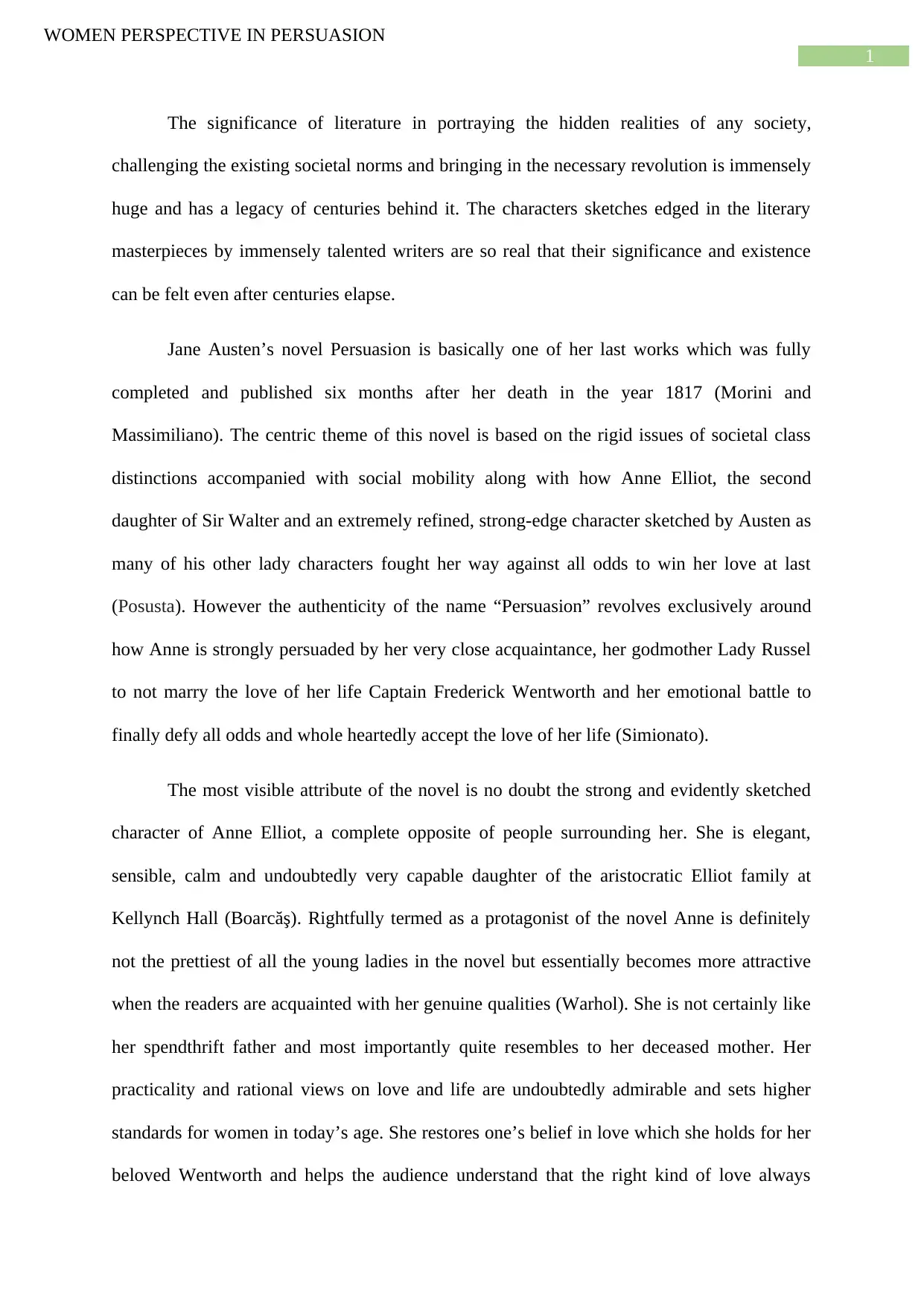
1
WOMEN PERSPECTIVE IN PERSUASION
The significance of literature in portraying the hidden realities of any society,
challenging the existing societal norms and bringing in the necessary revolution is immensely
huge and has a legacy of centuries behind it. The characters sketches edged in the literary
masterpieces by immensely talented writers are so real that their significance and existence
can be felt even after centuries elapse.
Jane Austen’s novel Persuasion is basically one of her last works which was fully
completed and published six months after her death in the year 1817 (Morini and
Massimiliano). The centric theme of this novel is based on the rigid issues of societal class
distinctions accompanied with social mobility along with how Anne Elliot, the second
daughter of Sir Walter and an extremely refined, strong-edge character sketched by Austen as
many of his other lady characters fought her way against all odds to win her love at last
(Posusta). However the authenticity of the name “Persuasion” revolves exclusively around
how Anne is strongly persuaded by her very close acquaintance, her godmother Lady Russel
to not marry the love of her life Captain Frederick Wentworth and her emotional battle to
finally defy all odds and whole heartedly accept the love of her life (Simionato).
The most visible attribute of the novel is no doubt the strong and evidently sketched
character of Anne Elliot, a complete opposite of people surrounding her. She is elegant,
sensible, calm and undoubtedly very capable daughter of the aristocratic Elliot family at
Kellynch Hall (Boarcăş). Rightfully termed as a protagonist of the novel Anne is definitely
not the prettiest of all the young ladies in the novel but essentially becomes more attractive
when the readers are acquainted with her genuine qualities (Warhol). She is not certainly like
her spendthrift father and most importantly quite resembles to her deceased mother. Her
practicality and rational views on love and life are undoubtedly admirable and sets higher
standards for women in today’s age. She restores one’s belief in love which she holds for her
beloved Wentworth and helps the audience understand that the right kind of love always
WOMEN PERSPECTIVE IN PERSUASION
The significance of literature in portraying the hidden realities of any society,
challenging the existing societal norms and bringing in the necessary revolution is immensely
huge and has a legacy of centuries behind it. The characters sketches edged in the literary
masterpieces by immensely talented writers are so real that their significance and existence
can be felt even after centuries elapse.
Jane Austen’s novel Persuasion is basically one of her last works which was fully
completed and published six months after her death in the year 1817 (Morini and
Massimiliano). The centric theme of this novel is based on the rigid issues of societal class
distinctions accompanied with social mobility along with how Anne Elliot, the second
daughter of Sir Walter and an extremely refined, strong-edge character sketched by Austen as
many of his other lady characters fought her way against all odds to win her love at last
(Posusta). However the authenticity of the name “Persuasion” revolves exclusively around
how Anne is strongly persuaded by her very close acquaintance, her godmother Lady Russel
to not marry the love of her life Captain Frederick Wentworth and her emotional battle to
finally defy all odds and whole heartedly accept the love of her life (Simionato).
The most visible attribute of the novel is no doubt the strong and evidently sketched
character of Anne Elliot, a complete opposite of people surrounding her. She is elegant,
sensible, calm and undoubtedly very capable daughter of the aristocratic Elliot family at
Kellynch Hall (Boarcăş). Rightfully termed as a protagonist of the novel Anne is definitely
not the prettiest of all the young ladies in the novel but essentially becomes more attractive
when the readers are acquainted with her genuine qualities (Warhol). She is not certainly like
her spendthrift father and most importantly quite resembles to her deceased mother. Her
practicality and rational views on love and life are undoubtedly admirable and sets higher
standards for women in today’s age. She restores one’s belief in love which she holds for her
beloved Wentworth and helps the audience understand that the right kind of love always
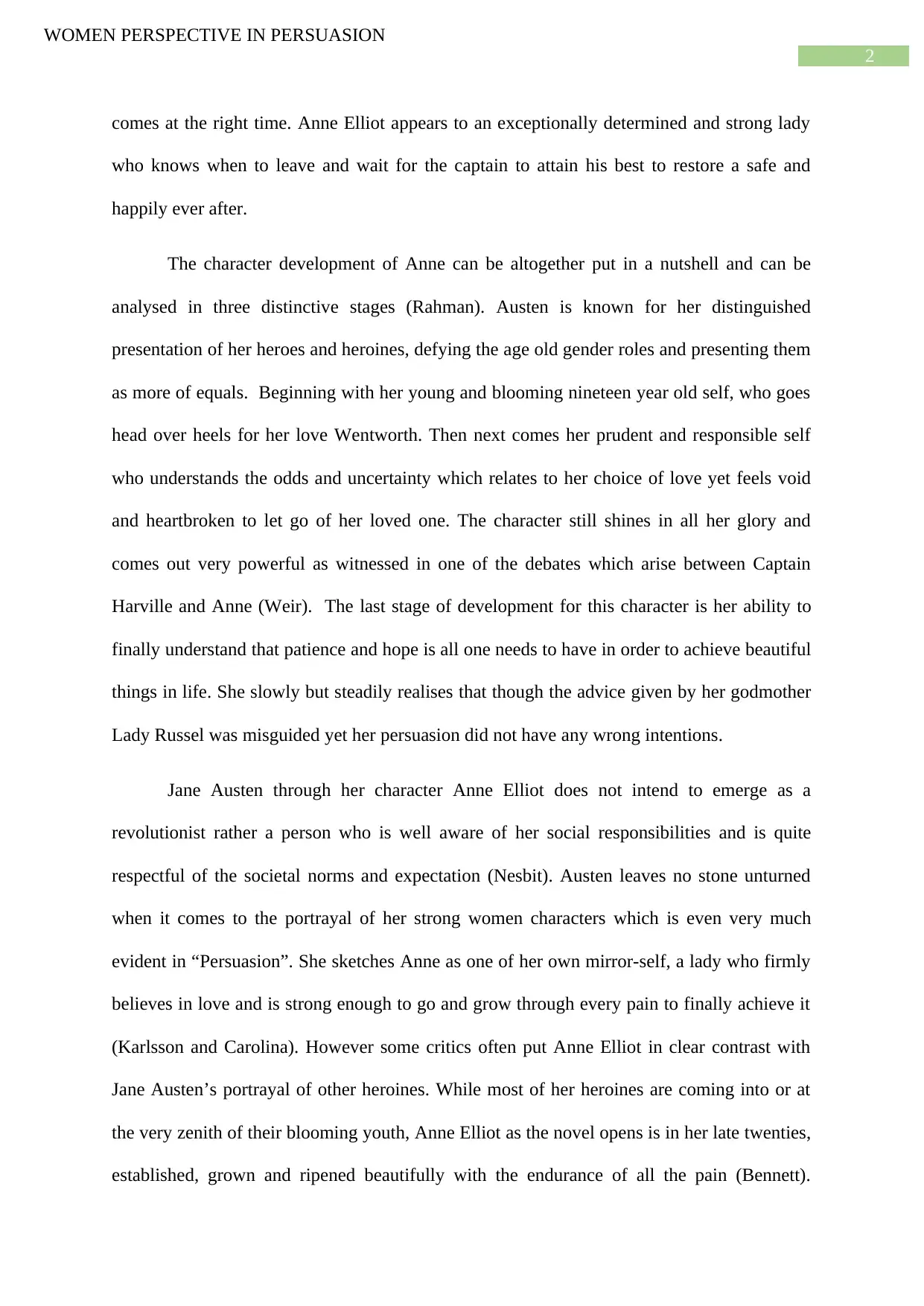
2
WOMEN PERSPECTIVE IN PERSUASION
comes at the right time. Anne Elliot appears to an exceptionally determined and strong lady
who knows when to leave and wait for the captain to attain his best to restore a safe and
happily ever after.
The character development of Anne can be altogether put in a nutshell and can be
analysed in three distinctive stages (Rahman). Austen is known for her distinguished
presentation of her heroes and heroines, defying the age old gender roles and presenting them
as more of equals. Beginning with her young and blooming nineteen year old self, who goes
head over heels for her love Wentworth. Then next comes her prudent and responsible self
who understands the odds and uncertainty which relates to her choice of love yet feels void
and heartbroken to let go of her loved one. The character still shines in all her glory and
comes out very powerful as witnessed in one of the debates which arise between Captain
Harville and Anne (Weir). The last stage of development for this character is her ability to
finally understand that patience and hope is all one needs to have in order to achieve beautiful
things in life. She slowly but steadily realises that though the advice given by her godmother
Lady Russel was misguided yet her persuasion did not have any wrong intentions.
Jane Austen through her character Anne Elliot does not intend to emerge as a
revolutionist rather a person who is well aware of her social responsibilities and is quite
respectful of the societal norms and expectation (Nesbit). Austen leaves no stone unturned
when it comes to the portrayal of her strong women characters which is even very much
evident in “Persuasion”. She sketches Anne as one of her own mirror-self, a lady who firmly
believes in love and is strong enough to go and grow through every pain to finally achieve it
(Karlsson and Carolina). However some critics often put Anne Elliot in clear contrast with
Jane Austen’s portrayal of other heroines. While most of her heroines are coming into or at
the very zenith of their blooming youth, Anne Elliot as the novel opens is in her late twenties,
established, grown and ripened beautifully with the endurance of all the pain (Bennett).
WOMEN PERSPECTIVE IN PERSUASION
comes at the right time. Anne Elliot appears to an exceptionally determined and strong lady
who knows when to leave and wait for the captain to attain his best to restore a safe and
happily ever after.
The character development of Anne can be altogether put in a nutshell and can be
analysed in three distinctive stages (Rahman). Austen is known for her distinguished
presentation of her heroes and heroines, defying the age old gender roles and presenting them
as more of equals. Beginning with her young and blooming nineteen year old self, who goes
head over heels for her love Wentworth. Then next comes her prudent and responsible self
who understands the odds and uncertainty which relates to her choice of love yet feels void
and heartbroken to let go of her loved one. The character still shines in all her glory and
comes out very powerful as witnessed in one of the debates which arise between Captain
Harville and Anne (Weir). The last stage of development for this character is her ability to
finally understand that patience and hope is all one needs to have in order to achieve beautiful
things in life. She slowly but steadily realises that though the advice given by her godmother
Lady Russel was misguided yet her persuasion did not have any wrong intentions.
Jane Austen through her character Anne Elliot does not intend to emerge as a
revolutionist rather a person who is well aware of her social responsibilities and is quite
respectful of the societal norms and expectation (Nesbit). Austen leaves no stone unturned
when it comes to the portrayal of her strong women characters which is even very much
evident in “Persuasion”. She sketches Anne as one of her own mirror-self, a lady who firmly
believes in love and is strong enough to go and grow through every pain to finally achieve it
(Karlsson and Carolina). However some critics often put Anne Elliot in clear contrast with
Jane Austen’s portrayal of other heroines. While most of her heroines are coming into or at
the very zenith of their blooming youth, Anne Elliot as the novel opens is in her late twenties,
established, grown and ripened beautifully with the endurance of all the pain (Bennett).
⊘ This is a preview!⊘
Do you want full access?
Subscribe today to unlock all pages.

Trusted by 1+ million students worldwide
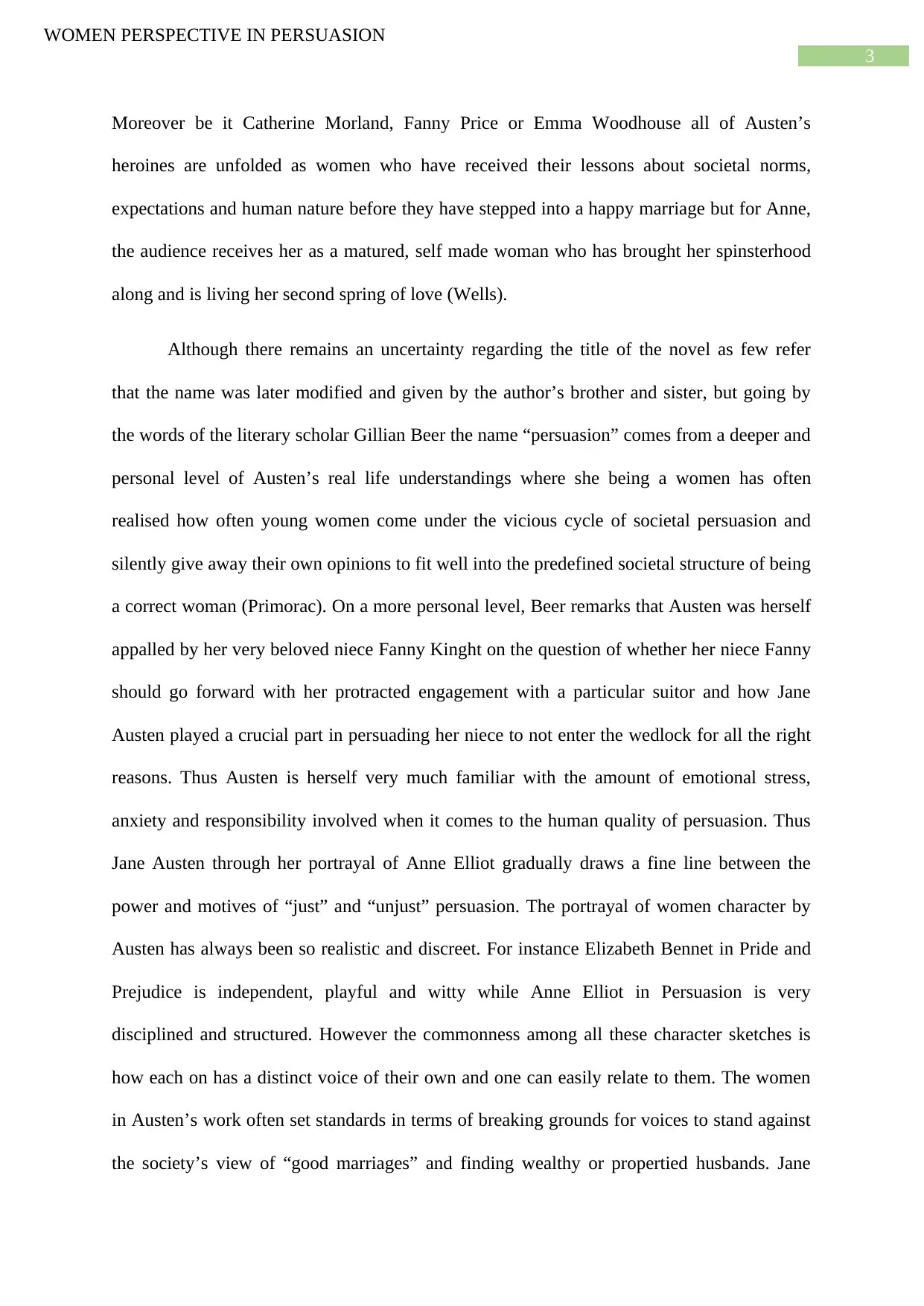
3
WOMEN PERSPECTIVE IN PERSUASION
Moreover be it Catherine Morland, Fanny Price or Emma Woodhouse all of Austen’s
heroines are unfolded as women who have received their lessons about societal norms,
expectations and human nature before they have stepped into a happy marriage but for Anne,
the audience receives her as a matured, self made woman who has brought her spinsterhood
along and is living her second spring of love (Wells).
Although there remains an uncertainty regarding the title of the novel as few refer
that the name was later modified and given by the author’s brother and sister, but going by
the words of the literary scholar Gillian Beer the name “persuasion” comes from a deeper and
personal level of Austen’s real life understandings where she being a women has often
realised how often young women come under the vicious cycle of societal persuasion and
silently give away their own opinions to fit well into the predefined societal structure of being
a correct woman (Primorac). On a more personal level, Beer remarks that Austen was herself
appalled by her very beloved niece Fanny Kinght on the question of whether her niece Fanny
should go forward with her protracted engagement with a particular suitor and how Jane
Austen played a crucial part in persuading her niece to not enter the wedlock for all the right
reasons. Thus Austen is herself very much familiar with the amount of emotional stress,
anxiety and responsibility involved when it comes to the human quality of persuasion. Thus
Jane Austen through her portrayal of Anne Elliot gradually draws a fine line between the
power and motives of “just” and “unjust” persuasion. The portrayal of women character by
Austen has always been so realistic and discreet. For instance Elizabeth Bennet in Pride and
Prejudice is independent, playful and witty while Anne Elliot in Persuasion is very
disciplined and structured. However the commonness among all these character sketches is
how each on has a distinct voice of their own and one can easily relate to them. The women
in Austen’s work often set standards in terms of breaking grounds for voices to stand against
the society’s view of “good marriages” and finding wealthy or propertied husbands. Jane
WOMEN PERSPECTIVE IN PERSUASION
Moreover be it Catherine Morland, Fanny Price or Emma Woodhouse all of Austen’s
heroines are unfolded as women who have received their lessons about societal norms,
expectations and human nature before they have stepped into a happy marriage but for Anne,
the audience receives her as a matured, self made woman who has brought her spinsterhood
along and is living her second spring of love (Wells).
Although there remains an uncertainty regarding the title of the novel as few refer
that the name was later modified and given by the author’s brother and sister, but going by
the words of the literary scholar Gillian Beer the name “persuasion” comes from a deeper and
personal level of Austen’s real life understandings where she being a women has often
realised how often young women come under the vicious cycle of societal persuasion and
silently give away their own opinions to fit well into the predefined societal structure of being
a correct woman (Primorac). On a more personal level, Beer remarks that Austen was herself
appalled by her very beloved niece Fanny Kinght on the question of whether her niece Fanny
should go forward with her protracted engagement with a particular suitor and how Jane
Austen played a crucial part in persuading her niece to not enter the wedlock for all the right
reasons. Thus Austen is herself very much familiar with the amount of emotional stress,
anxiety and responsibility involved when it comes to the human quality of persuasion. Thus
Jane Austen through her portrayal of Anne Elliot gradually draws a fine line between the
power and motives of “just” and “unjust” persuasion. The portrayal of women character by
Austen has always been so realistic and discreet. For instance Elizabeth Bennet in Pride and
Prejudice is independent, playful and witty while Anne Elliot in Persuasion is very
disciplined and structured. However the commonness among all these character sketches is
how each on has a distinct voice of their own and one can easily relate to them. The women
in Austen’s work often set standards in terms of breaking grounds for voices to stand against
the society’s view of “good marriages” and finding wealthy or propertied husbands. Jane
Paraphrase This Document
Need a fresh take? Get an instant paraphrase of this document with our AI Paraphraser

4
WOMEN PERSPECTIVE IN PERSUASION
Austen has often been regarded as a radical writer who has time and again challenged the
orthodox patriarchal expectations that the society tries to impose on women and helped the
gender voice its opinion and preserve its autonomy
One of the most significant reasons of reading Jane Austen’s novels and gaining such
an immense response among its readers is the universality of themes and plots that Austen
chose to work on (Spicer.). Taking about “Persuasion” one of the eminent theme is the idea
of a second chance at love and how ones struggles, pain and misery altogether helps in
building up a more responsible self who is ready to take more challenges and helps gained
such an immense response amongst its readers (Rowberry and Simon). Another very
important feature which helps to achieve Austen such excellence at her work is her
exceptionally authentic portrayal of relationships. For instance the relation between Anne and
Lay Russell, their interactions and dilemmas are so real that the audience even after centuries
can still easily connect with the plot (Steiner). The romance incorporated in “Persuasion” is
dealt with utmost mellowness which in turn helps in developing the character of Anne Elliot
creating stark difference between the other characters present in the plot. This is the prime
reason that the modern audience of today can still very easily connect with the characters and
more specifically with Annie Elliot’s journey of self growth and fulfilment.
There from the above cited discussion it can be clearly understood that the
belief and principles of the author is very well depicted in all her works. Particularly
concentrating on “Persuasion”, the novel has received immense intelligent criticisms in the
recent years after a prolonged period of comparative neglect. Unlike Austen’s other works
where the whole plot revolves around the characters changing, here in Persuasion it depends
upon the main characters retaining their originality. According to the eminent American
Scholar Adela Pinch “Persuasion” can be undoubtedly termed as the most lyrical works of
Austen (Russett).Persuasion has also been subjected to several adaptations be it television
WOMEN PERSPECTIVE IN PERSUASION
Austen has often been regarded as a radical writer who has time and again challenged the
orthodox patriarchal expectations that the society tries to impose on women and helped the
gender voice its opinion and preserve its autonomy
One of the most significant reasons of reading Jane Austen’s novels and gaining such
an immense response among its readers is the universality of themes and plots that Austen
chose to work on (Spicer.). Taking about “Persuasion” one of the eminent theme is the idea
of a second chance at love and how ones struggles, pain and misery altogether helps in
building up a more responsible self who is ready to take more challenges and helps gained
such an immense response amongst its readers (Rowberry and Simon). Another very
important feature which helps to achieve Austen such excellence at her work is her
exceptionally authentic portrayal of relationships. For instance the relation between Anne and
Lay Russell, their interactions and dilemmas are so real that the audience even after centuries
can still easily connect with the plot (Steiner). The romance incorporated in “Persuasion” is
dealt with utmost mellowness which in turn helps in developing the character of Anne Elliot
creating stark difference between the other characters present in the plot. This is the prime
reason that the modern audience of today can still very easily connect with the characters and
more specifically with Annie Elliot’s journey of self growth and fulfilment.
There from the above cited discussion it can be clearly understood that the
belief and principles of the author is very well depicted in all her works. Particularly
concentrating on “Persuasion”, the novel has received immense intelligent criticisms in the
recent years after a prolonged period of comparative neglect. Unlike Austen’s other works
where the whole plot revolves around the characters changing, here in Persuasion it depends
upon the main characters retaining their originality. According to the eminent American
Scholar Adela Pinch “Persuasion” can be undoubtedly termed as the most lyrical works of
Austen (Russett).Persuasion has also been subjected to several adaptations be it television
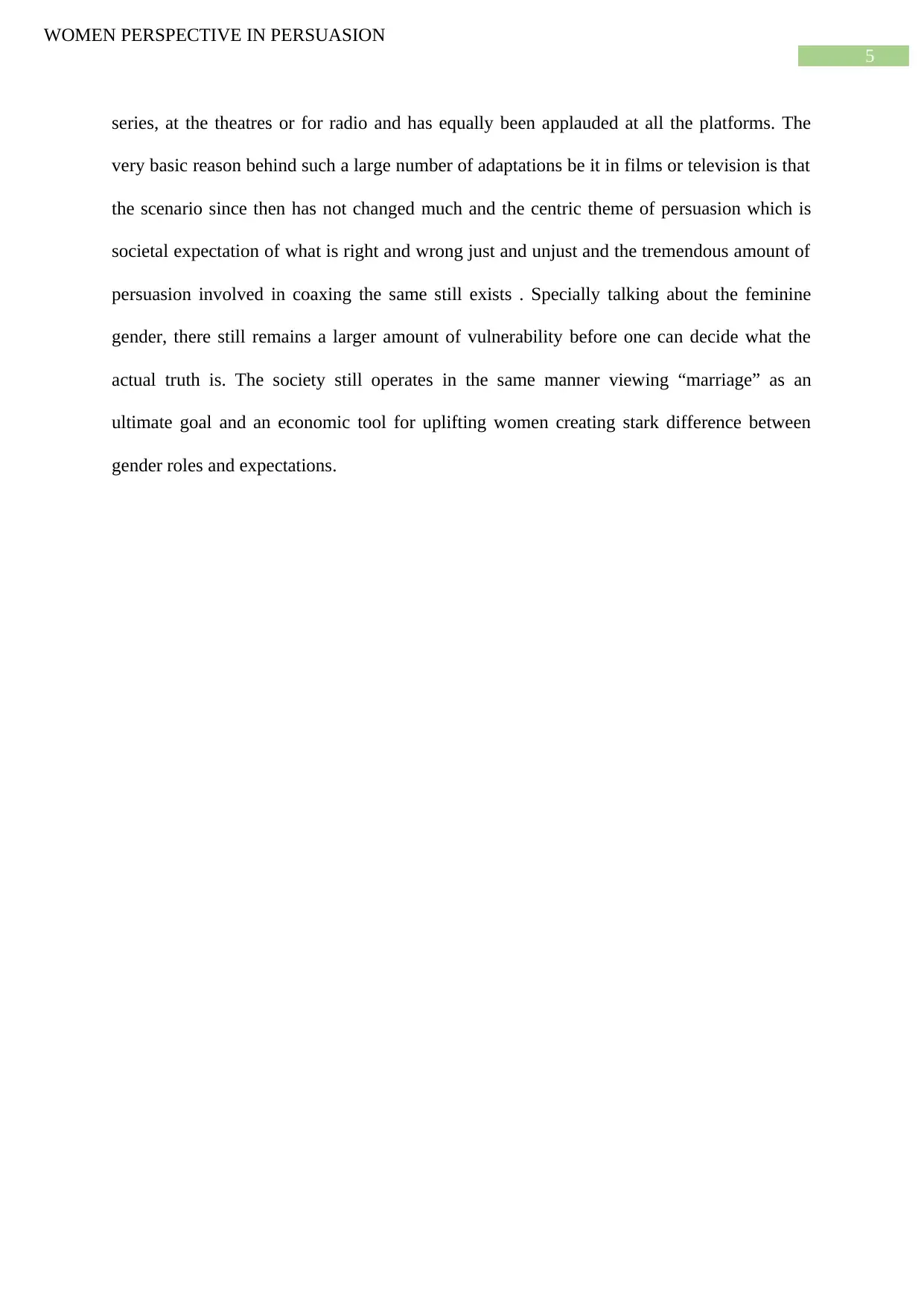
5
WOMEN PERSPECTIVE IN PERSUASION
series, at the theatres or for radio and has equally been applauded at all the platforms. The
very basic reason behind such a large number of adaptations be it in films or television is that
the scenario since then has not changed much and the centric theme of persuasion which is
societal expectation of what is right and wrong just and unjust and the tremendous amount of
persuasion involved in coaxing the same still exists . Specially talking about the feminine
gender, there still remains a larger amount of vulnerability before one can decide what the
actual truth is. The society still operates in the same manner viewing “marriage” as an
ultimate goal and an economic tool for uplifting women creating stark difference between
gender roles and expectations.
WOMEN PERSPECTIVE IN PERSUASION
series, at the theatres or for radio and has equally been applauded at all the platforms. The
very basic reason behind such a large number of adaptations be it in films or television is that
the scenario since then has not changed much and the centric theme of persuasion which is
societal expectation of what is right and wrong just and unjust and the tremendous amount of
persuasion involved in coaxing the same still exists . Specially talking about the feminine
gender, there still remains a larger amount of vulnerability before one can decide what the
actual truth is. The society still operates in the same manner viewing “marriage” as an
ultimate goal and an economic tool for uplifting women creating stark difference between
gender roles and expectations.
⊘ This is a preview!⊘
Do you want full access?
Subscribe today to unlock all pages.

Trusted by 1+ million students worldwide
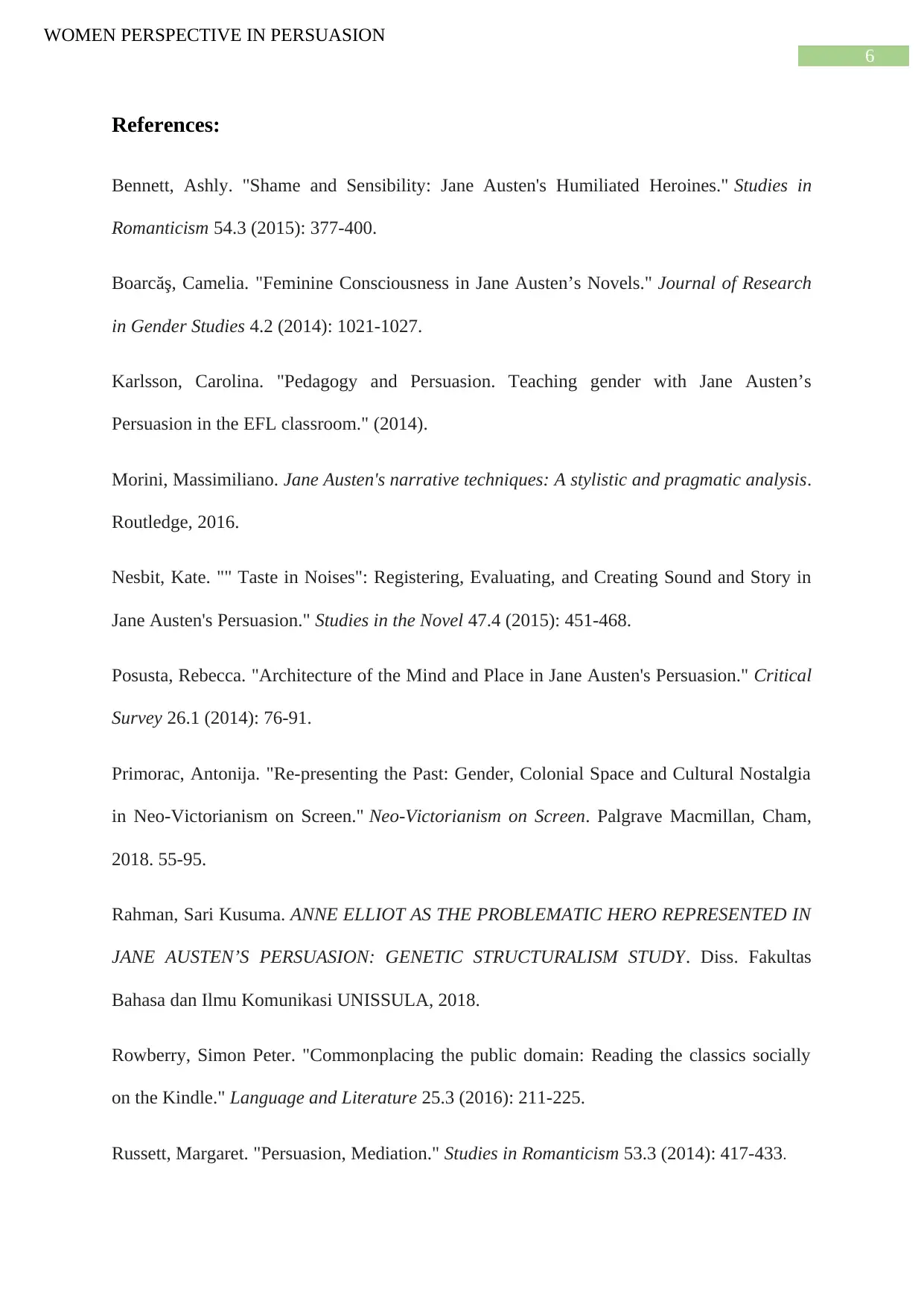
6
WOMEN PERSPECTIVE IN PERSUASION
References:
Bennett, Ashly. "Shame and Sensibility: Jane Austen's Humiliated Heroines." Studies in
Romanticism 54.3 (2015): 377-400.
Boarcăş, Camelia. "Feminine Consciousness in Jane Austen’s Novels." Journal of Research
in Gender Studies 4.2 (2014): 1021-1027.
Karlsson, Carolina. "Pedagogy and Persuasion. Teaching gender with Jane Austen’s
Persuasion in the EFL classroom." (2014).
Morini, Massimiliano. Jane Austen's narrative techniques: A stylistic and pragmatic analysis.
Routledge, 2016.
Nesbit, Kate. "" Taste in Noises": Registering, Evaluating, and Creating Sound and Story in
Jane Austen's Persuasion." Studies in the Novel 47.4 (2015): 451-468.
Posusta, Rebecca. "Architecture of the Mind and Place in Jane Austen's Persuasion." Critical
Survey 26.1 (2014): 76-91.
Primorac, Antonija. "Re-presenting the Past: Gender, Colonial Space and Cultural Nostalgia
in Neo-Victorianism on Screen." Neo-Victorianism on Screen. Palgrave Macmillan, Cham,
2018. 55-95.
Rahman, Sari Kusuma. ANNE ELLIOT AS THE PROBLEMATIC HERO REPRESENTED IN
JANE AUSTEN’S PERSUASION: GENETIC STRUCTURALISM STUDY. Diss. Fakultas
Bahasa dan Ilmu Komunikasi UNISSULA, 2018.
Rowberry, Simon Peter. "Commonplacing the public domain: Reading the classics socially
on the Kindle." Language and Literature 25.3 (2016): 211-225.
Russett, Margaret. "Persuasion, Mediation." Studies in Romanticism 53.3 (2014): 417-433.
WOMEN PERSPECTIVE IN PERSUASION
References:
Bennett, Ashly. "Shame and Sensibility: Jane Austen's Humiliated Heroines." Studies in
Romanticism 54.3 (2015): 377-400.
Boarcăş, Camelia. "Feminine Consciousness in Jane Austen’s Novels." Journal of Research
in Gender Studies 4.2 (2014): 1021-1027.
Karlsson, Carolina. "Pedagogy and Persuasion. Teaching gender with Jane Austen’s
Persuasion in the EFL classroom." (2014).
Morini, Massimiliano. Jane Austen's narrative techniques: A stylistic and pragmatic analysis.
Routledge, 2016.
Nesbit, Kate. "" Taste in Noises": Registering, Evaluating, and Creating Sound and Story in
Jane Austen's Persuasion." Studies in the Novel 47.4 (2015): 451-468.
Posusta, Rebecca. "Architecture of the Mind and Place in Jane Austen's Persuasion." Critical
Survey 26.1 (2014): 76-91.
Primorac, Antonija. "Re-presenting the Past: Gender, Colonial Space and Cultural Nostalgia
in Neo-Victorianism on Screen." Neo-Victorianism on Screen. Palgrave Macmillan, Cham,
2018. 55-95.
Rahman, Sari Kusuma. ANNE ELLIOT AS THE PROBLEMATIC HERO REPRESENTED IN
JANE AUSTEN’S PERSUASION: GENETIC STRUCTURALISM STUDY. Diss. Fakultas
Bahasa dan Ilmu Komunikasi UNISSULA, 2018.
Rowberry, Simon Peter. "Commonplacing the public domain: Reading the classics socially
on the Kindle." Language and Literature 25.3 (2016): 211-225.
Russett, Margaret. "Persuasion, Mediation." Studies in Romanticism 53.3 (2014): 417-433.
Paraphrase This Document
Need a fresh take? Get an instant paraphrase of this document with our AI Paraphraser
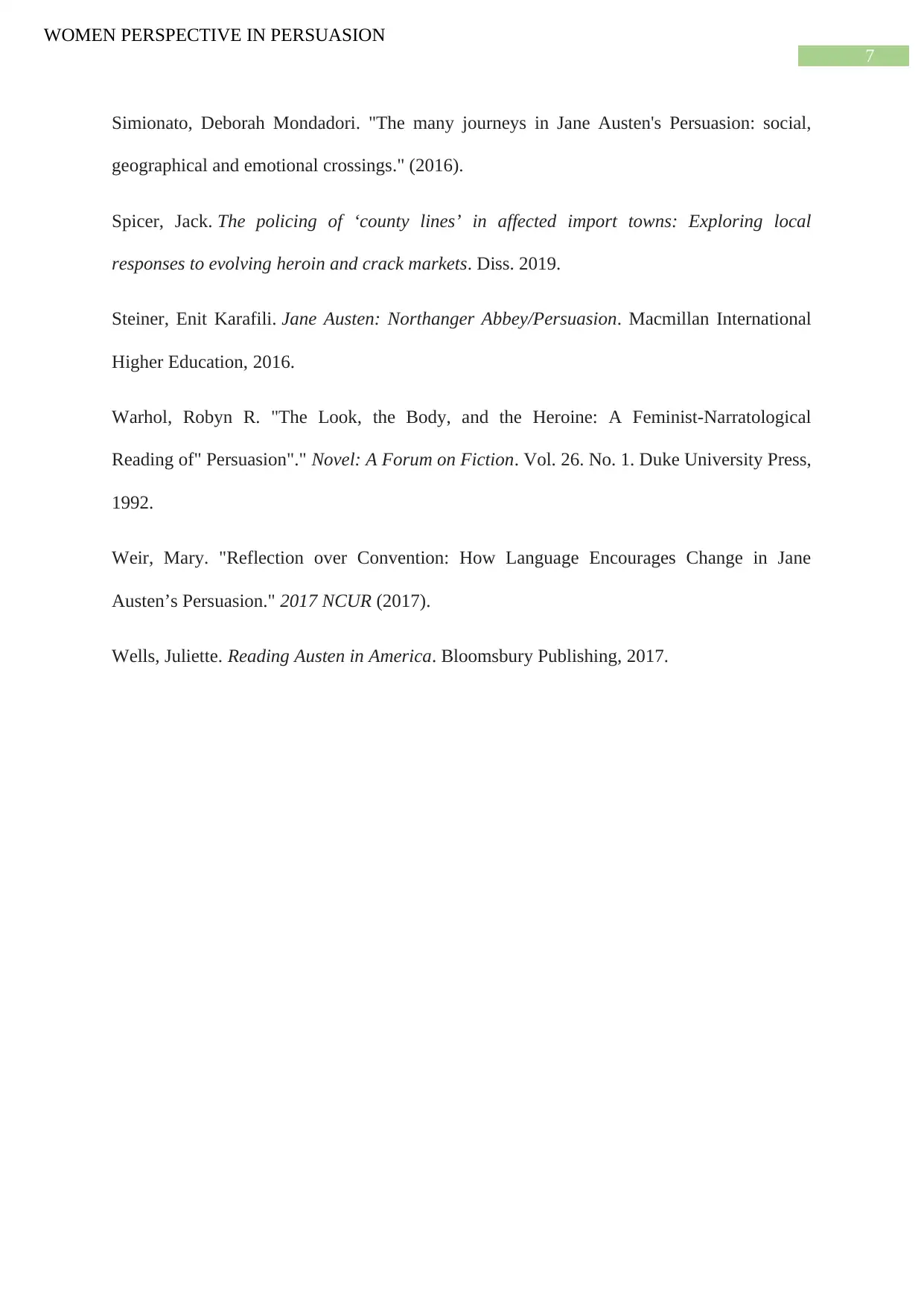
7
WOMEN PERSPECTIVE IN PERSUASION
Simionato, Deborah Mondadori. "The many journeys in Jane Austen's Persuasion: social,
geographical and emotional crossings." (2016).
Spicer, Jack. The policing of ‘county lines’ in affected import towns: Exploring local
responses to evolving heroin and crack markets. Diss. 2019.
Steiner, Enit Karafili. Jane Austen: Northanger Abbey/Persuasion. Macmillan International
Higher Education, 2016.
Warhol, Robyn R. "The Look, the Body, and the Heroine: A Feminist-Narratological
Reading of" Persuasion"." Novel: A Forum on Fiction. Vol. 26. No. 1. Duke University Press,
1992.
Weir, Mary. "Reflection over Convention: How Language Encourages Change in Jane
Austen’s Persuasion." 2017 NCUR (2017).
Wells, Juliette. Reading Austen in America. Bloomsbury Publishing, 2017.
WOMEN PERSPECTIVE IN PERSUASION
Simionato, Deborah Mondadori. "The many journeys in Jane Austen's Persuasion: social,
geographical and emotional crossings." (2016).
Spicer, Jack. The policing of ‘county lines’ in affected import towns: Exploring local
responses to evolving heroin and crack markets. Diss. 2019.
Steiner, Enit Karafili. Jane Austen: Northanger Abbey/Persuasion. Macmillan International
Higher Education, 2016.
Warhol, Robyn R. "The Look, the Body, and the Heroine: A Feminist-Narratological
Reading of" Persuasion"." Novel: A Forum on Fiction. Vol. 26. No. 1. Duke University Press,
1992.
Weir, Mary. "Reflection over Convention: How Language Encourages Change in Jane
Austen’s Persuasion." 2017 NCUR (2017).
Wells, Juliette. Reading Austen in America. Bloomsbury Publishing, 2017.
1 out of 8
Your All-in-One AI-Powered Toolkit for Academic Success.
+13062052269
info@desklib.com
Available 24*7 on WhatsApp / Email
![[object Object]](/_next/static/media/star-bottom.7253800d.svg)
Unlock your academic potential
Copyright © 2020–2025 A2Z Services. All Rights Reserved. Developed and managed by ZUCOL.